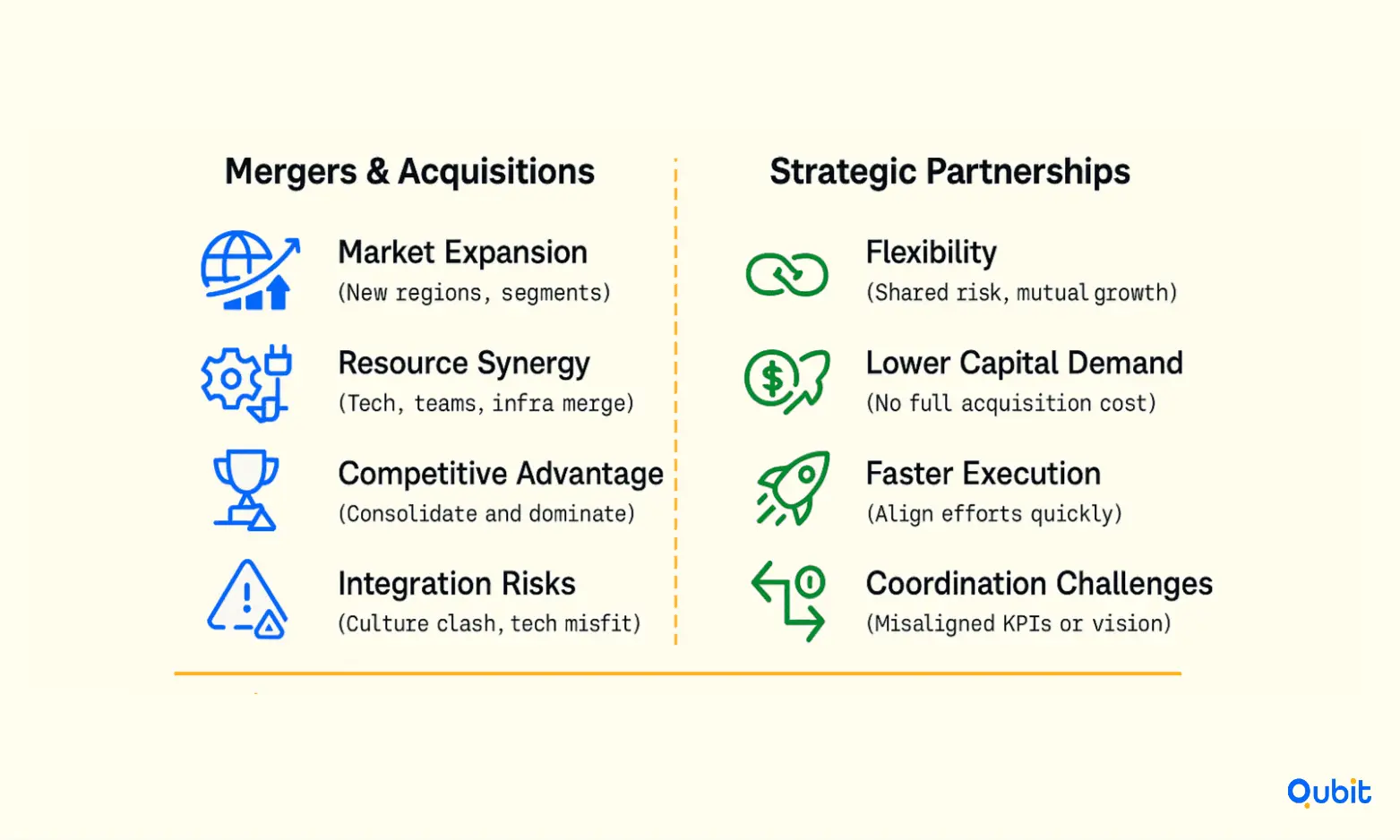When evaluating startup opportunities, investors often face a pivotal decision: should they buy the company outright or form a strategic partnership? This choice can significantly impact long-term returns and the dynamics of the relationship. The “buy vs partner” debate hinges on factors like market timing, resource allocation, and alignment with business goals.
The article is designed for investors and founders assessing growth strategies. You will explores the nuances of both approaches, offering actionable insights to help you make informed decisions. Let’s jump right in.
Evaluating Strategic Options: Buy vs Partner, Mergers & Acquisitions
Recent quarters have seen sustained momentum. In Q2 2024, M&A deal activity reached 158 transactions, the fourth-highest total since early 2019. Deal volume grew by 10% in Q4 2023, then climbed another 5% and 4% in subsequent quarters, demonstrating ongoing appetite for strategic transactions. This signals a favorable environment for evaluating both acquisitions and partnerships.
When businesses aim for growth, they often face a critical decision: pursue organic strategies or explore inorganic avenues like mergers, acquisitions, and partnerships. Each approach offers unique advantages and challenges. It is essential to evaluate these options carefully.
This section delves into the nuances of mergers and acquisitions (commonly abbreviated as M&A) alongside strategic partnerships, providing insights into their benefits, potential hurdles, and frameworks for decision-making.

Mergers and Acquisitions: A Path to Accelerated Growth
Mergers and acquisitions are often synonymous with rapid expansion. By acquiring or merging with another company, businesses can gain access to new markets, technologies, and customer bases almost instantly. According to Carta, M&A activity has seen significant fluctuations in recent years, reflecting broader economic trends and industry-specific dynamics. For instance, tech startups have been a focal point for acquisitions, as larger firms seek to integrate innovative solutions into their portfolios.
Recent market activity illustrates these dynamics. The T-Mobile / US Cellular merger finalized in August 2025, with a transaction value of $4.3 billion. This telecommunications deal highlights how strategic acquisitions can rapidly expand market presence and capabilities.
M&A Risks: Integration and Talent Retention Challenges
While mergers and acquisitions can accelerate growth, they also carry substantial risks, including high failure rates and integration difficulties. Many deals falter due to cultural misalignment, unclear roles, or loss of key talent after acquisition. These challenges can undermine expected value and disrupt business continuity. Careful planning for integration and employee retention is essential to improve the odds of long-term success.
Advantages of M&A
- Market Expansion: M&A allows companies to enter new geographic regions or market segments without starting from scratch. This can be particularly beneficial in industries with high barriers to entry.
- Resource Integration: Combining resources, such as talent, technology, and infrastructure, can create synergies—where combined resources generate more value than the sum of separate parts.
- Competitive Edge: Acquiring a competitor can eliminate market rivalry, consolidate market share, and strengthen a company’s position.
Challenges of M&A
However, mergers and acquisitions are not without risks. Integration issues often arise, particularly when company cultures clash or operational systems fail to align. Additionally, the financial burden of an acquisition can strain resources, especially if the expected synergies do not materialize.
For investors and businesses considering early-stage acquisitions, understanding the broader frameworks is crucial. Your understanding of acquisition decisions deepens when you integrate the startup acquisition strategies outlined in this guide, which connects broad frameworks with early-stage investment insights.
Strategic Partnerships: Collaboration Over Competition
While M&A focuses on ownership, strategic partnerships emphasize collaboration. These alliances enable businesses to pool resources, share risks, and achieve mutual goals without the complexities of integration.
Benefits of Strategic Partnerships
- Flexibility: Unlike mergers, partnerships allow companies to maintain their independence while working together on specific projects or initiatives.
- Cost Efficiency: Partnerships often require less financial investment compared to acquisitions, making them an attractive option for smaller businesses.
- Shared Expertise: Collaborating with another company can bring in complementary skills and knowledge, enhancing the overall value proposition.
Limitations of Partnerships
Despite their advantages, partnerships can face challenges such as misaligned objectives, unequal contributions, or conflicts over decision-making. Clear agreements and regular communication are essential to mitigate these risks.
Understanding when to plan for startup acquisition is crucial, as aligning preparation with market opportunities can refine your strategy. For investors, the key lies in assessing whether acquiring the startup or collaborating through a partnership will deliver the desired outcomes.
Buy vs. Partner Spectrum
The buy vs partner decision shapes how investors approach acquisition or collaboration with startups.
- Acquisition (Buy):
Acquiring a startup outright means taking ownership (often 100% or a controlling stake) and integrating the company into the investor’s portfolio or operations. This route provides full control over assets, technology, and talent. Timelines matter for buy decisions. The acquisition process typically takes six to twelve months from preparation to closing. This period covers due diligence, negotiation, and deal integration. Knowing these timing expectations helps investors plan realistic strategies when choosing between buying or partnering. - Strategic Partnership:
Partnering involves collaboration without a full acquisition. Investors may co-develop technology, share market access, or sign exclusive deals, but the startup remains independent. Partnerships enable shared risk, flexible engagement, and faster market testing.
Choosing the Right Framework
Selecting between mergers, acquisitions, and partnerships depends on several factors, including the company’s goals, resources, and risk tolerance. A structured evaluation process can help businesses make informed decisions:
- Define Objectives: Clarify what the company aims to achieve, whether it’s market expansion, technological advancement, or cost reduction.
- Assess Compatibility: Evaluate potential partners or acquisition targets for cultural, operational, and strategic alignment.
- Conduct Due Diligence: Thoroughly analyze financials, legal considerations, and market conditions to minimize risks.
- Plan Integration: For M&A, develop a detailed integration plan to address potential challenges and ensure a smooth transition.
By weighing the pros and cons of each option and applying a systematic approach, businesses can identify the strategy that best aligns with their long-term vision.
Keep in mind: Regulations or founder conflict may complicate some deals.
Ensuring Business Success
Achieving long-term business success requires more than just ambition; it demands a structured approach to evaluating and adapting strategies. Smart investors use buy vs partner frameworks to ensure their business decisions support sustained success.
Whether through mergers and acquisitions (M&A) or partnerships, businesses must continuously refine their methods to stay competitive in dynamic markets. This section explores a clear framework for sustained growth, supported by expert insights, practical tools, and real-world examples.
Essential Steps for Post-Merger Integration
- Establish a dedicated integration team to align culture, processes, and communication across both organizations from day one.
- Identify and retain key talent by addressing employee concerns, offering incentives, and promoting shared values early in the transition.
- Ensure regulatory compliance by reviewing all legal obligations, updating policies, and coordinating with relevant authorities throughout the integration.
Evaluating endurance is just as important as planning for growth. According to recent data, 65.1% of businesses fail within ten years, while 21.5% do not survive even the first year. Awareness of these odds should guide every step from partnership planning to acquisition integration.
Key Factors Investors Evaluate
Key factors help investors decide whether to buy vs partner with a startup.
1. Strategic Alignment
- Buy if: The startup’s product, intellectual property, or team is central to the investor’s long-term vision or key business line.
- Partner if: The startup’s solution complements existing operations without being mission-critical.
2. Risk and Resource Appetite
- Buy if: The investor is eager to commit significant capital, shoulder integration or scaling risks, and absorb the entity fully.
- Partner if: There’s uncertainty about the startup’s scalability or market fit, or the investor seeks to test collaboration outcomes first.
3. Speed and Agility
- Buy if: Rapid integration offers a competitive edge—such as quickly owning a disruptive technology or accessing a new market.
- Partner if: The market is evolving, and agility/flexibility matter more than full control.
4. Deal Cost and Valuation
- Buy if: The startup’s valuation is attractive and the acquisition cost is justified by synergies or long-term gains.
- Partner if: Acquisition would be too expensive or dilute returns, but collaboration still offers value.
5. Talent and Cultural Fit
- Buy if: There’s strong cultural alignment and the investor wants to retain the startup’s team, often to drive innovation in-house.
- Partner if: Integrating teams may be disruptive, or the startup’s leadership prefers independence.
The United States remains the primary hub for ambitious investors. In 2025, the U.S. ecosystem captured 57% of global venture capital investment. This dominance underscores why U.S.-based startups and investors enjoy unique resource and dealmaking advantages.
Building and Maintaining Strong Investor Relationships
Successful startup-investor relationships extend well beyond financial transactions. Trust, transparency, and aligned expectations form the foundation of partnerships that fuel sustainable growth.
- Clear, Transparent Communication: Openly sharing progress, challenges, and milestones fosters trust. Regular updates, tailored to investor preferences, keep investors engaged and proactive rather than reactive.
- Mutual Trust and Accountability: Trust develops when both parties honor commitments and maintain honesty. Founders who own their decisions build credibility, while investors who provide constructive support become true partners.
- Engagement Beyond Funding: Effective investors contribute strategic insights, introduce networks, and help navigate challenges. Founders benefit from involving investors in key discussions and valuing diverse expertise.
- Tailored Investor Management: Segment investors by type and interests, and customize communications accordingly. Institutional VCs, business angels, or corporate investors require different engagement approaches.
- Long-Term Perspective: Strong relationships withstand market shifts and challenges, enabling smoother pivots, future fundraising, and successful exits. Foundations built on collaboration and respect dramatically improve startup outcomes.
Best Practices for Smart Decision-Making
- Start with Alignment: Ensure business goals, values, and growth outlooks are well matched.
- Conduct Rigorous Due Diligence: Go beyond financials, scrutinize technology, culture, and market fit.
- Benchmark Against Alternatives: Compare other potential targets or partners before committing.
- Plan for Integration and Exit (for Acquisitions): Develop a thorough integration plan and possible exit strategies if goals aren’t met.
- Draft Clear Partnership Agreements: Define roles, milestones, IP ownership, and exit options explicitly.
Conclusion
A buy vs partner mindset helps investors make strategic decisions about startup relationships. Evaluating mergers, acquisitions, and partnerships requires a thoughtful approach grounded in data and strategic foresight. By focusing on key insights, businesses can make informed decisions that align with their long-term goals. Using data-driven frameworks ensures clarity when weighing the benefits of buying versus partnering, reducing risks and maximizing opportunities.
Strategic alignment is not just a buzzword, it’s the foundation for sustainable growth. Whether you’re exploring a merger or considering a partnership, aligning these decisions with your broader business objectives is essential for success.
If you’re an investor seeking expert guidance, we at Qubit Capital are ready to help you connect with high-potential startups. Explore our Startup Matchmaking service to find the best opportunities for your growth strategy. Let’s work together to turn your vision into reality.
Key Takeaways
Understanding the buy vs partner spectrum is essential for smart investment decisions.
- A comprehensive framework helps investors decide between buying and partnering with startups.
- Mergers can offer resource pooling but come with significant integration challenges.
- Acquisitions require meticulous planning and competitive analysis.
- Strategic partnerships enhance market reach while presenting challenges in alignment and culture.
- Continuous evaluation and expert guidance are crucial for long-term business success.
Frequently asked Questions
How do investors decide between buying a startup and forming a partnership?
Investors decide based on strategic alignment, resource requirements, and market timing. Assessing risks and long-term goals helps clarify the buy vs partner choice.






